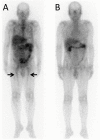Spontaneous remission of giant cell arteritis: possible association with a preceding acute respiratory infection and seropositivity to Chlamydia pneumoniae antibodies
- PMID: 30962664
- PMCID: PMC6433628
- DOI: 10.18999/nagjms.81.1.151
Spontaneous remission of giant cell arteritis: possible association with a preceding acute respiratory infection and seropositivity to Chlamydia pneumoniae antibodies
Abstract
Recent epidemiological or immunopathological studies demonstrate the possible association between giant cell arteritis and infectious agents including Chlamydia pneumoniae. A 62-year-old Japanese man with type 1 diabetes mellitus developed biopsy-proven giant cell arteritis after acute upper respiratory infection. Serological examination indicated concurrent re-infection with C. pneumoniae. Clinical manifestations of the vasculitis subsided within a month without any immunosuppressive therapy, and no relapse was observed for the following 12 months. The natural history of this disease is unclear and spontaneous remission is rarely reported. The self-limiting nature of the infection could contribute to this phenomenon.
Keywords: Chlamydia pneumoniae; giant cell arteritis; spontaneous remission.
Conflict of interest statement
The authors declare no conflicts of interest in association with the present study.
Figures





Similar articles
-
Serum levels of antibodies to Chlamydia pneumoniae and human HSP60 in giant cell arteritis patients.Clin Exp Rheumatol. 2008 Nov-Dec;26(6):1107-10. Clin Exp Rheumatol. 2008. PMID: 19210880
-
Temporal arteritis associated with Chlamydia pneumoniae DNA detected in an artery specimen.J Rheumatol. 2000 Nov;27(11):2718-20. J Rheumatol. 2000. PMID: 11093461
-
Prevalence of Chlamydia pneumoniae in acute respiratory tract infection and detection of anti-Chlamydia pneumoniae-specific IgE in Japanese children with reactive airway disease.Kurume Med J. 2001;48(2):165-70. doi: 10.2739/kurumemedj.48.165. Kurume Med J. 2001. PMID: 11501498
-
[A new respiratory tract pathogen].Mikrobiyol Bul. 1991 Apr;25(2):194-205. Mikrobiyol Bul. 1991. PMID: 1745154 Review. Turkish.
-
Is giant cell arteritis an infectious disease? Biological and epidemiological evidence.Presse Med. 2004 Nov 6;33(19 Pt 2):1403-8. doi: 10.1016/s0755-4982(04)98939-7. Presse Med. 2004. PMID: 15615251 Review.
Cited by
-
Self-limited Giant Cell Arteritis: The Dilemma Associated with Its Diagnosis and Treatment.Intern Med. 2025 Mar 15;64(6):959-963. doi: 10.2169/internalmedicine.3840-24. Epub 2024 Aug 10. Intern Med. 2025. PMID: 39135253 Free PMC article.
References
-
- Frohman L, Wong AB, Matheos K, Leon-Alvarado LG, Danesh-Meyer HV. New developments in giant cell arteritis. Surv Ophthalmol. 2016;61(4):400–421. - PubMed
-
- van Timmeren MM, Heeringa P, Kallenberg CG. Infectious triggers for vasculitis. Curr Opin Rheumatol. 2014;26(4):416–423. - PubMed
-
- Jennette JC, Falk RJ, Bacon PA, et al. 2012 revised International Chapel Hill Consensus Conference nomenclature of vasculitides. Arthritis Rheum. 2013;65(1):1–11. - PubMed
-
- Meskimen S, Cook TD, Blake RL Jr. Management of giant cell arteritis and polymyalgia rheumatica. Am Fam Physician. 2000;61(7):2061–2068. - PubMed
-
- Salvarani C, Pipitone N, Versari A, Hunder GG. Clinical features of polymyalgia rheumatic and giant cell arteritis. Nat Rev Rheumatol. 2012;8(9):509–521. - PubMed
Publication types
MeSH terms
Substances
LinkOut - more resources
Full Text Sources
Medical
